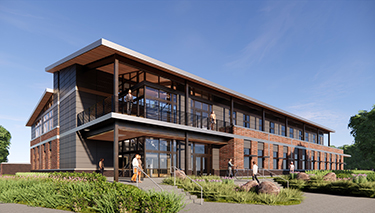|
Subscribe / Renew |
|
|
Contact Us |
|
| ► Subscribe to our Free Weekly Newsletter | |
| home | Welcome, sign in or click here to subscribe. | login |
Architecture & Engineering
| |
 |
March 30, 2023
Equitable development: nice to have or essential best practice?
Mackenzie

Mason
|
Nearly every conversation on business strategy, planning, and development, echoes a focus on diversity, equity, and inclusion (DEI) issues. Now more than ever, companies are recognizing that data and research underpin the business case for not only evaluating their organizational policies and procedures with DEI but that it is imperative to business practice to foster and shape all aspects of an organization’s responsibility and role in society.
This subject matter is nothing new to design firms. As champions of the public’s health, safety, and welfare, protecting people and the planet is fundamental to those involved in architecture and engineering design disciplines. Inclusive, trauma-informed, and critical race design approaches are existing methodologies already practiced in specific project types.
However, with the crescendo of Black Lives Matter and the Me Too movements, companies ask themselves, “How equitable are our projects? Were diverse community voices heard in the process, thus eliminating disparity, particularly racial disparities? Am I attracting a diverse talent pool?”
In 2022, several publications were released that explored variations of the subject matter. Racial equity in commercial real estate, equitable economic development, and environmental, social, and governance (ESG) are some of the numerous social concerns researched and published. A recurring fundamental question arises, “What exactly is equitable development?”
The nonprofit Urban Land Institute Northwest chapter held a discussion in Seattle based on its piece “10 Principles for Embedding Racial Equity in Real Estate Development,” published in 2022. In addition to amazing speakers, industry professionals in commercial real estate, A&E design, and students from University of Washington’s Runstad Department of Real Estate, gathered to hear short talks and learn about Seattle’s history of redlining and its impact on racial inequities in real estate. Conversations like these are happening nationally as individuals seek to discover ways to embed racial equity in their day-to-day work.
An explanation produced by the U.S. Environmental Protection Agency in its website section on Environmental Justice describes equitable development this way, “Equitable development is driven by priorities and values as well as clear expectations that the outcomes from development need to be responsive to underserved populations and vulnerable groups, in addition to using innovative design strategies and sustainable policies.”
Policies and practices are how companies manifest their equitable priorities and values to cement their commitment to protecting the environment and implementing practices that reflect clean energy, green technology, and efforts to move towards carbon-positive operations. In particular, publicly traded companies openly discuss these practices in their annual reports that reflect on outcomes beyond their financial conditions. They tell their own equitable development story with the realization that to remain relevant and strategic, companies must move environmental, social and governance from “nice to have” to essential best practice as a business framework that considers and prioritizes people, clients, the planet, and community.
According to the International Economic Development Council, “Equitable Economic Development promotes economic well-being and improves the quality of life in communities by creating and retaining jobs, enhancing wealth, and providing a stable tax base. Equitable economic development is achieved when every member of a community is able to share in and benefit from economic growth.”
As place makers, professionals in A&E play a crucial role in improving the quality of life in the communities they design. Whether the design challenge is a community park, a redeveloped retail center, a college campus, or a master plan for a key economic center for business and commerce, the linkages to equitable economic improvements are ameliorated.
More than ever, our projects are seeing participation by people in communities most impacted by development. Communities want a more inclusive and equitable development or redevelopment project with engagement and an opportunity to share their voice. Methods that offer this feedback loop during a project’s early stages help shape decisions and determine if an equity lens has been integrated. Projects like Rassekh Park, Silverton Civic Center, and Lynnwood Community Recovery Center are just a few notable projects at Mackenzie where engagement went beyond simply public notices. Community advisory boards arose, and continue to be one of the means to provide opportunities for often marginalized community members to be heard and centered.
Places and spaces have a tremendous opportunity to enhance the health and wellbeing of those who live and work in neighborhoods, cities, and states. Achieving equitable and inclusive growth and development is a high priority of government, business and community leaders, and at every turn. Equitable development includes pathways to build a healthy workforce, fostering upward wealth mobility, and creating more resilient communities with equal access to opportunities.
As the finish line comes into view of any project, the hope is that they reveal transformative impacts, like living wage job creation, investment in local infrastructure, support for community-based organizations, and increased civic and neighborhood pride. As illustrated above, there are varying definitions of equitable design. Situations and desired outcomes necessitate a tailored and unique approach to each development scenario. It depends on the context and yet, when equity is absent, unintended consequences often damage residents, visitors, commuters, and the community.
As the business of design continues to mature, clients, employees, the community, and the government are challenging the project framework when it comes to determining inclusive and equitable design. It goes beyond the statistics of how diverse and inclusive the project team members are and what percentage of the fee was paid to minority, women and disadvantaged business enterprises. It includes determining if diversity influences values, ideas, and perspectives and whether multiple perspectives, identities, and cultures are represented.
Jan Mason is an associate principal at Mackenzie and serves as the director of communications and equitable design.
Other Stories:
- In Edmonds, a park runs through it
- Engineering gets specialized in response to increasing complexity
- At Glover Middle School, the lighting runs through it
- Engineering solutions, as waters rise
- Revitalizing downtowns with office-to-residential conversion
- Structures and sustainability: pursuing net-zero carbon emissions
- Employee ownership for all: an alternative to the ESOP
- New form of team work needed for multifamily projects
- So you want to be a rock star (marketer)
- Natural direction is a new path in architecture



